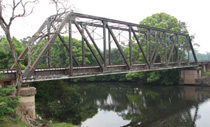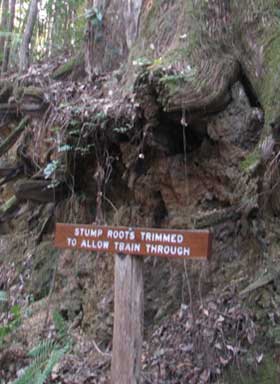Have just returned from a heady week of ideas and words at the Watermark Literary Muster in the village of Kendall, NSW. Being broke as usual, I was most grateful for an offer of free accommodation from Peta Simmons, a woman whose generosity is as large as her laugh. She’d never met me, just wanted to help writers.
Her guest ‘humpy’ turned out to be to be a cute cottage behind her house, all on one large deck. Hidden behind trees, it was right beside the railway line, the railway crossing and the railway bridge over the lazy brown river.
 This gave me a novel experience – being awoken by the dinging of the level crossing bells before being shaken by the rising roar of the train as it belted past and over the metal bridge. The house is built of steel, on big recycled steel posts, deeply embedded in the ground on rubber-topped pads. The train tremor reverberates through the whole house and the bodies of its inhabitants. Yet this was a thrill rather a worry: the place felt extremely secure and I went back to sleep each time.
This gave me a novel experience – being awoken by the dinging of the level crossing bells before being shaken by the rising roar of the train as it belted past and over the metal bridge. The house is built of steel, on big recycled steel posts, deeply embedded in the ground on rubber-topped pads. The train tremor reverberates through the whole house and the bodies of its inhabitants. Yet this was a thrill rather a worry: the place felt extremely secure and I went back to sleep each time.
Its other plus is that it is right on the river, which, in between long slow drifts of leaves, blinked with the coloured reflections of a passenger express or a goods train as it flew over the criss-crossed steel suspension bridge.
 On the last day of the Muster, we were taken by the Kendall Historical Society up into the mountains behind the village, for a walk along the old Longworth Logging Tramway.
On the last day of the Muster, we were taken by the Kendall Historical Society up into the mountains behind the village, for a walk along the old Longworth Logging Tramway.
Here logging trains were inched over wooden rails, past giant trees, and across log bridges in gullies, to take the timber down to the very river next to which I’d been sleeping. This was how delicate selective logging used to be before giant companies and giant machines invented clearfelling.
Our guide had owned a timber company: we agreed that unsustainable logging practices were unnecessary and had caused many of the industry problems and the closures.
We both shook sorrowful heads at the waste of good timber in the whole wood pulp disaster. Good greenies and good loggers are in agreement here.